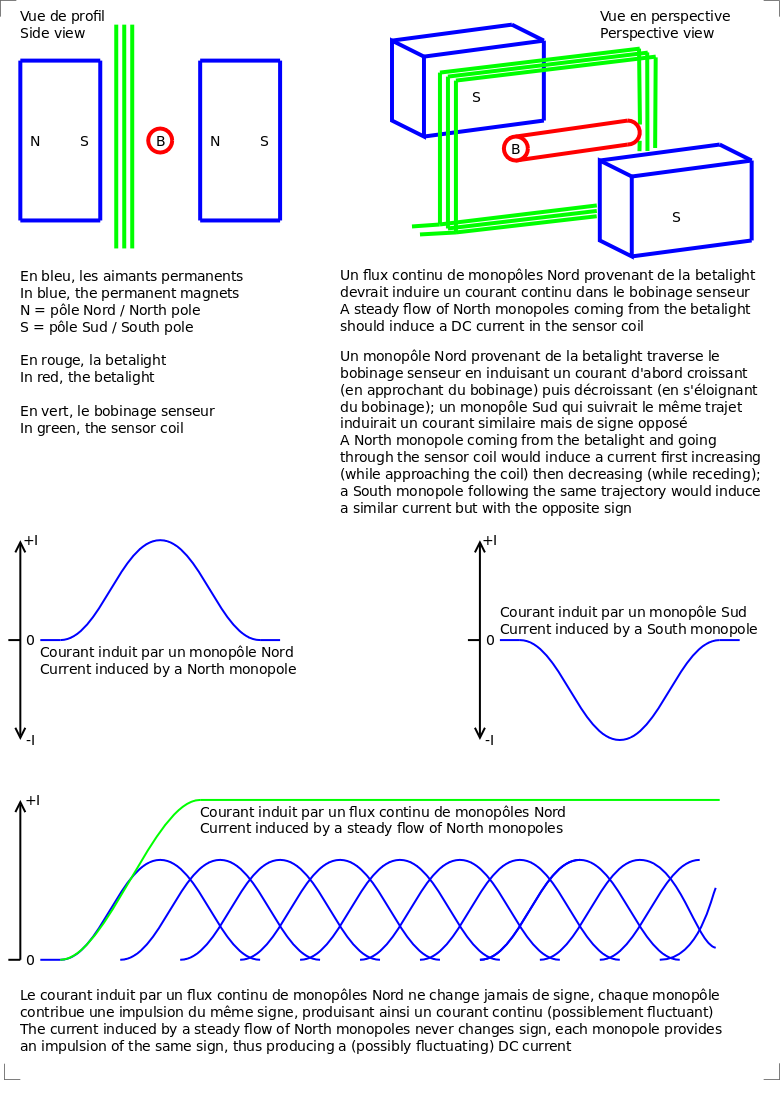Design & construction of a magnetic monopoles stream detector
Texts, photos & pictures copyright (©) 2016-2018 Norman Molhant,
please note that all informations are in the public domain.
back to the index page en français
- A betalight with 1 Curie of Tritium will produce at most 37*10^9 neutrinos per second.
- Placed in the field of a strong magnet, it will produce at most 37*10^9 LMM per second.
- If each LMM accelerates 1 electron while going through a single turn coil,
the above LMM stream will produce a current of at most 37*10^9 electrons per second,
i.e.: a tad less than 5,93 nanoamps (1 amp = 6,241*10^18 electrons per second).
- As a unit magnetic charge has 137/2 times the energy of a unit electric charge,
it seems possible that each LMM will produce instead a current of 67,5*37*10^9 electrons per second,
i.e.: about 335 nanoamps - this should be experimentally tested.
- Following Blas Cabrera's reasoning (First Results from a Superconductive Detector for
Moving Magnetic Monopoles, Blas Cabrera, Physical Review Letters Vol. 48 No. 20 pp 1378-1381,
17 May 1982), the intensity of the current induced in the sensor coil should be proportional
to the number of turns in the coil.
- Hence, using a 8192 turns sensor coil, one would expect a maximum current of either 2640
microamps or 40 microamps, depending whether point 4 applies or not.
- In fact, each neutrino produced by the betalight has only a finite probability (not calculated)
to form a LMM, hence the current induced in the sensor coil will certainly be much lower than these numbers.
- It is much easier to measure a few microamps than a few nanoamps; furthermore nanoamps
could easily be masked by the thermal noise of the circuits.
- In order to test this, I'll build a 8192 turns sensor coil (inner diameter 32 mm, outside
diameter about 54 mm, width 20 mm, made of 0,12 mm diameter enameled copper wire), then connect it to a
simple electronic circuit able to either directly measure the DC current in the coil or integrate
this current during a preset time.

- Such a 8192 turns sensor coil (32 mm inside diameter, 54 mm outside diameter, 20 mm width,
made of 0,12 mm diameter enameled copper wire) will have an impedance around 2,64 henrys and
will strongly pick any power hum (50 Hz in Europe, 60 Hz in America), while the signal induced
by the monopoles will remain quite weak.
- Hence, I'll have to build a preamp circuit to
- transform the DC current produced by the sensor coil into an adequately amplified DC voltage, and
- strongly attenuate both the power hum and any other AC signal picked by the sensor coil.


